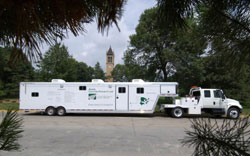Project Details
08-320, TR-579
09/04/07
01/30/15
Federal Highway Administration
Iowa Department of Transportation
Iowa Highway Research Board
Midwest Transportation Consortium
Texas Department of Transportation
Researchers
Neal Hawkins
hawkins@iastate.edu email >Director Research Administration, ISU
About the research
Lane departure crashes are a significant safety concern. The majority of lane departure crashes occur on rural two-lane roadways, with a disproportionate number of these crashes on horizontal curves. Curve-related crashes involve a number of roadway and driver causative factors. A primary driver factor is speeding.
Dynamic speed feedback sign (DSFS) systems are one method to reduce vehicle speeds and, consequently, crashes on curves. These systems show promise but they have not been fully evaluated on curves. The Center for Transportation Research and Education at Iowa State University conducted a national demonstration project to evaluate the effectiveness of two different DSFSs in reducing speed and crashes on curves at 22 total sites on rural two-lane roadways in seven States. The goal is to provide traffic safety engineers and other professionals with additional tools to manage speeds and crashes on rural horizontal curves more effectively.
Data were collected before and at 1, 12, and 24 months after installation of the DSFS. On average, most sites had decreases in mean speeds, with decreases up to 10.9 miles per hour (mph) noted for both the point of curvature (PC) and center of curve (CC). Most sites experienced changes in 85th percentile speed of 3 mph or more at the PC, with the majority of sites having a decrease of 2 mph at the CC. The numbers of vehicles traveling 5, 10, 15, or 20 mph over the posted or advisory speed limit were also compared. Large reductions in the number of vehicles traveling over the posted or advisory speed occurred for all of the after periods at the PC and CC, indicating that the signs were effective in reducing high-end speeds, as well as average and 85th percentile speeds.
A before-and-after crash analysis was also conducted, and crash modification factors (CMF) were developed. CMFs ranged from 0.93 to 0.95 depending on the crash type and direction of the crash.
Funding Sources:
Federal Highway Administration ($300,000.00)
Iowa Department of Transportation ($30,000.00)
Iowa Highway Research Board ($80,000.00)
Midwest Transportation Consortium ($71,769.00)
Texas Department of Transportation ($120,000.00)
Total: $601,769.00
Project Details
02/01/03
12/01/07
American Concrete Pavement Association
Concrete paving industry
Federal Highway Administration
Georgia Department of Transportation
Indiana Department of Transportation
Iowa Department of Transportation
Kansas Department of Transportation
Lousiana Department of Transportation
Michigan Department of Transportation
Minnesota Department of Transportation
Nebraska Department of Roads
New York State Department of Transportation
North Carolina Department of Transportation
North Dakota Department of Transportation
Ohio Department of Transportation
Oklahoma Department of Transportation
South Dakota Department of Transportation
Texas Department of Transportation
Wisconsin Department of Transportation
Researchers
Jim Grove
Fatih Bektas
About the research
The objectives of this five-year Transportation Pooled Fund study are to evaluate conventional and new technologies and procedures for testing concrete and concrete materials to prevent material and construction problems that could lead to premature concrete pavement distress, and to develop a suite of tests that provides a comprehensive method of ensuring long-term pavement performance. A preliminary suite of tests to ensure long-term pavement performance has been developed. Shadow construction projects are being conducted to evaluate the preliminary suite of tests. A mobile concrete testing laboratory has been designed and equipped to facilitate the shadow projects. The results of the project are being compiled in a user-friendly field manual, which will be available by summer 2006.

